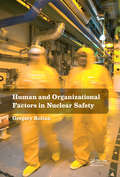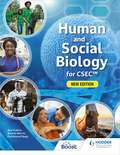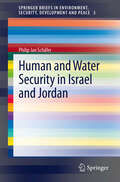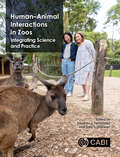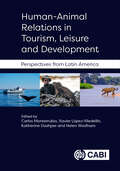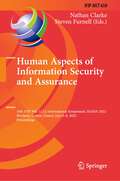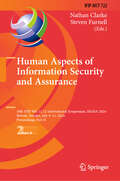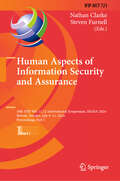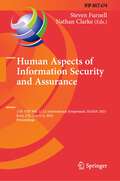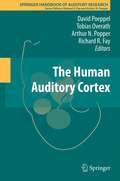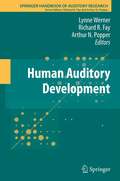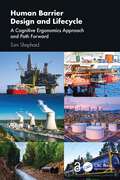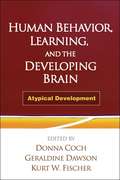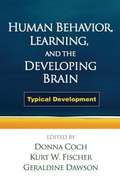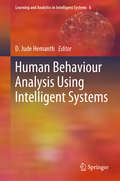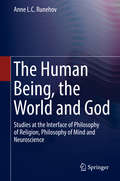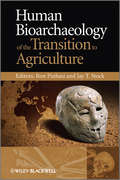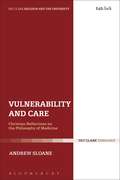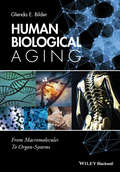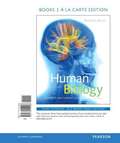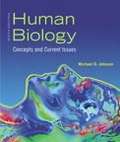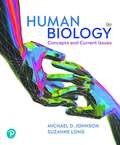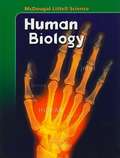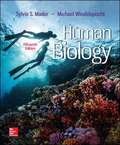- Table View
- List View
Human and Organizational Factors in Nuclear Safety: The French Approach to Safety Assessments
by Gregory RolinaThis book discusses the specifics of safety regulations regarding nuclear risk and the safety of nuclear installations. The author shows that (French) regulations concerning nuclear safety depend on maintaining a technical dialogue between the ASN, IRSN and nuclear operators. In the face of an ongoing European and global re-evaluation of the safety of nuclear power and alignment towards the Anglo-Saxon standard, the French approach may yet be able to make a significant contribution. This work will be of interest to all involved in nuclear power engineering and in the field of risk management and nuclear safety.
Human and Social Biology for CSEC
by Ann FullickProvide a comprehensive and engaging student-centred approach to Human and Social Biology with an updated textbook aligned to the latest CSEC syllabus for examination from June 2022. - Cover all topics with brand new content on the environment, diseases and pandemics with a full focus on their impact in the Caribbean - Develop subject knowledge with 'Did you know?' features; and consolidate learning using objectives, end of section checkpoint questions and summaries within each chapter- Create meaningful links with 'The Biologist's Toolkit' feature to strengthen maths, science and language skills needed to meet the course objectives- Support application of practical tasks via step-by-step guidance on how to research, present and analyse data, and come to realistic conclusions and recommendations - Avoid common errors with an increased focus on 'What the Examiners say' for problem topicsAdded for the eBook- Aid visual learning using diagrams, illustrations, video links and demonstrations in the eBook
Human and Social Biology for CSEC
by Ann FullickProvide a comprehensive and engaging student-centred approach to Human and Social Biology with an updated textbook aligned to the latest CSEC syllabus for examination from June 2022. - Cover all topics with brand new content on the environment, diseases and pandemics with a full focus on their impact in the Caribbean - Develop subject knowledge with 'Did you know?' features; and consolidate learning using objectives, end of section checkpoint questions and summaries within each chapter- Create meaningful links with 'The Biologist's Toolkit' feature to strengthen maths, science and language skills needed to meet the course objectives- Support application of practical tasks via step-by-step guidance on how to research, present and analyse data, and come to realistic conclusions and recommendations - Avoid common errors with an increased focus on 'What the Examiners say' for problem topicsAdded for the eBook- Aid visual learning using diagrams, illustrations, video links and demonstrations in the eBook
Human and Water Security in Israel and Jordan
by Philip Jan SchäferThe work aims at answering the question as to how far discourses on human security are present in Jordan and Israel, if they converge and if political solutions for the issue of water security could be derived. The analysis is based on the assumption that from human security perspective common solutions for urgent problems can be derived more easily than out of a perspective of national security. Yet it is acknowledged that according to a new security perspective different security threats are being identified by relevant actors. An empirical analysis of written statements and utterances of the respective security elites establishes the methodological tool for the identification of human security discourses in Israel and Jordan. Subsequently it is estimated how far water is presented as a matter of national security in Israel and Jordan using the theory of securitization.
Human-Animal Interactions in Zoos: Integrating Science and Practice
by Terry L. Maple Courtney Collins Amanda D. Webber Ellen Williams Geoff Hosey Vicky Melfi Sarah Webber Samantha J. Chiew Jon Coe Neil D’Cruze Angela J Dean Polly Doodson Lucy Dumbell Ashley N. Edes Kelly S Fielding Georgina Groves Lauren M. Hemsworth Paul H. Hemsworth Julia Hoy Violet Hunton Mark J. Learmonth Emily M McLeod Georgia Oaten Chris Pawson Bonnie M. Perdue David M. Powell Samantha WardHuman-Animal Interactions (HAI) are a primary welfare interest to both animal scientists and practitioners. In zoos and aquariums, the study of Animal-Visitor Interactions (AVI), including both the impact of visitors on animals (the visitor effect) and the impact of animals on visitors (the visitor experience), have become a focus for understanding HAIs in zoos. The study of HAIs in zoos has grown to consider a number of factors, including animal-staff interactions and bonds, modern exhibit design and technology, direct and indirect interactions, as well as positive and negative impacts on both animals and visitor alike. This thought-provoking book summarizes the latest research concerning the impacts of HAIs in zoos, including considerations for conducting research and managing HAIs. The book: Explores the interactions of animals with keepers, veterinary professionals, and other staff, and the effects of those interactions on the welfare of animals. Considers the impact of visitors on the well-being of animals. Covers the effects of interactions on education and the visitor experience. Outlines the use of technology to enhance experience, and improve animal welfare. Details theoretical, ethical, and practical considerations relevant to HAIs in zoos. An invaluable resource for animal behaviour and welfare scientists, students and practitioners, as well as anyone working with zoo animals.
Human-Animal Relations in Tourism, Leisure and Development: Perspectives from Latin America
by Carlos Monterrubio Xavier López-Medellín Katherine Dashper Helen WadhamHumans and animals have developed multiple and complex interactions in the fields of tourism, leisure, and development. However, much of the existing research on how humans and animals interact in these fields has emerged from within the context of developed countries. As a result, little has been documented about human-animal interactions in the socioeconomic, cultural, and environmental contexts of countries in the Global South. Specifically, the diversity and complexity of interspecies relationships in tourism, leisure, and local development in Latin America have been largely ignored in Anglo-Saxon literature. This has resulted in a limited, partial, and hegemonic understanding and debate about human-animal relationships globally, dominated by certain regions of the world. This book addresses this gap by documenting multiple and complex relationships between humans and animals in the fields of tourism, leisure, and local development in countries in Latin America. The book: Brings together empirical and conceptual works that reveal different disciplinary, theoretical, ethical, methodological, and practical perspectives. Reveals how human-animal relationships - both domestic and wild - can result in co-created interspecies experiences, conflicts, conservation efforts, welfare, and local development of human societies in the region. Equips stakeholders with conceptual frameworks and actionable tools to formulate policies that blend animal welfare and sustainability in Latin American tourism and recreation strategies. Challenges dominant narratives from the Global North regarding tourism and conservation, promoting a more inclusive and nuanced approach. This book will be of interest to researchers, professionals and policymakers within tourism, leisure, animal welfare, conservation and destination development.
Human Aspects of Information Security and Assurance: 16th IFIP WG 11.12 International Symposium, HAISA 2022, Mytilene, Lesbos, Greece, July 6–8, 2022, Proceedings (IFIP Advances in Information and Communication Technology #658)
by Nathan Clarke Steven FurnellThis book constitutes the proceedings of the 16th IFIP WG 11.12 International Symposium on Human Aspects of Information Security and Assurance, HAISA 2022, held in Mytilene, Lesbos, Greece, in July 2022. The 25 papers presented in this volume were carefully reviewed and selected from 30 submissions. They are organized in the following topical sections: cyber security education and training; cyber security culture; privacy; and cyber security management.
Human Aspects of Information Security and Assurance: 18th IFIP WG 11.12 International Symposium, HAISA 2024, Skövde, Sweden, July 9–11, 2024, Proceedings, Part II (IFIP Advances in Information and Communication Technology #722)
by Nathan Clarke Steven FurnellThe two-volume set IFIP AICT 721 +722 constitutes the proceedings of the 18th IFIP WG 11.12 International Symposium on Human Aspects of Information Security and Assurance, HAISA 2024, held in Skövde, Sweden, in July 9–11, 2024. The 39 full papers presented were carefully reviewed and selected from 55 submissions. The papers are organized in the following topical sections: Part I - Management and Risk; Social Engineering; Technical Attacks and Defenses; Usable Security. Part II - Awareness and Education; Privacy.
Human Aspects of Information Security and Assurance: 18th IFIP WG 11.12 International Symposium, HAISA 2024, Skövde, Sweden, July 9–11, 2024, Proceedings, Part I (IFIP Advances in Information and Communication Technology #721)
by Nathan Clarke Steven FurnellThe two-volume set IFIP AICT 721 + 722 constitutes the proceedings of the 18th IFIP WG 11.12 International Symposium on Human Aspects of Information Security and Assurance, HAISA 2024, held in Skövde, Sweden, in July 9–11, 2024. The 39 full papers presented were carefully reviewed and selected from 55 submissions. The papers are organized in the following topical sections: Part I - Management and Risk; Social Engineering; Technical Attacks and Defenses; Usable Security. Part II - Awareness and Education; Privacy.
Human Aspects of Information Security and Assurance: 17th IFIP WG 11.12 International Symposium, HAISA 2023, Kent, UK, July 4–6, 2023, Proceedings (IFIP Advances in Information and Communication Technology #674)
by Steven Furnell Nathan ClarkeThis book constitutes the proceedings of the 17th IFIP WG 11.12 International Symposium on Human Aspects of Information Security and Assurance, HAISA 2023, held in Kent, United Kingdom, in July 2023. The 37 full papers presented in this volume were carefully reviewed and selected from 54 submissions. They are organized in the following topical sections: education and training; management, policy and skills; evolving threats and attacks; social-technical factors; and research methods.
The Human Auditory Cortex
by Arthur N. Popper David Poeppel Richard R. Fay Tobias OverathWe live in a complex and dynamically changing acoustic environment. To this end, the auditory cortex of humans has developed the ability to process a remarkable amount of diverse acoustic information with apparent ease. In fact, a phylogenetic comparison of auditory systems reveals that human auditory association cortex in particular has undergone extensive changes relative to that of other species, although our knowledge of this remains incomplete. In contrast to other senses, human auditory cortex receives input that is highly pre-processed in a number of sub-cortical structures; this suggests that even primary auditory cortex already performs quite complex analyses. At the same time, much of the functional role of the various sub-areas in human auditory cortex is still relatively unknown, and a more sophisticated understanding is only now emerging through the use of contemporary electrophysiological and neuroimaging techniques. The integration of results across the various techniques signify a new era in our knowledge of how human auditory cortex forms basis for auditory experience. This volume on human auditory cortex will have two major parts. In Part A, the principal methodologies currently used to investigate human auditory cortex will be discussed. Each chapter will first outline how the methodology is used in auditory neuroscience, highlighting the challenges of obtaining data from human auditory cortex; second, each methods chapter will provide two or (at most) three brief examples of how it has been used to generate a major result about auditory processing. In Part B, the central questions for auditory processing in human auditory cortex are covered. Each chapter can draw on all the methods introduced in Part A but will focus on a major computational challenge the system has to solve. This volume will constitute an important contemporary reference work on human auditory cortex. Arguably, this will be the first and most focused book on this critical neurological structure. The combination of different methodological and experimental approaches as well as a diverse range of aspects of human auditory perception ensures that this volume will inspire novel insights and spurn future research.
Human Auditory Development
by Arthur N. Popper Richard R. Fay Lynne WernerThis volume will provide an important contemporary reference on hearing development and will lead to new ways of thinking about hearing in children and about remediation for children with hearing loss. Much of the material in this volume will document that a different model of hearing is needed to understand hearing during development. The book is expected to spur research in auditory development and in its application to pediatric audiology.
Human Barrier Design and Lifecycle: A Cognitive Ergonomics Approach and Path Forward
by Tom ShephardA common source of failure in a human‑dependent barrier or safety critical task is a designed‑in mismatch error. The mismatch is a cognitive demand that exceeds the human capability to reliably and promptly respond to that demand given the plausible situations at that moment. Demand situations often include incomplete information, increased time pressures, and challenging environments. This book presents innovative solutions to reveal, prevent, and mitigate these and many other cognitive‑type errors in barriers and safety critical tasks. The comprehensive model and methodologies also provide insight into where and to what extent these barriers and task types may be significantly underspecified and the potential consequences.This title presents a new and comprehensive prototype design and lifecycle model specific to human‑dependent barriers and safety critical tasks. Designed to supplement current practice, the model is fully underpinned by cognitive ergonomics and cognitive science. The book also presents a compelling case for why a new global consensus standard specific to human‑dependent barriers is needed. Taking a novel approach, it presents its suggested basis, framing, and content. Both solutions seek to redress deficiencies in global regulations, standards, and practice. The model is guided by industry recommendations and best practice guidance and solutions from globally recognized experts. Its processes are fully explained and supported by examples, analysis, and well‑researched background materials. Real‑life case studies from offshore oil and gas, chemical manufacturing, transmission pipelines, and product storage provide further insight into how overt and latent design errors contributed to barrier degradation and failure and the consequence of those errors.An essential and fascinating read for professionals, Human Barrier Design and Lifecycle: A Cognitive Ergonomics Approach and Path Forward will appeal to those in the fields of human factors, process and technical safety, functional safety, display and safety system design, risk management, facility engineering, and facility operations and maintenance.Chapters 1 and 8 of this book are freely available as downloadable Open Access PDFs at http://www.taylorfrancis.com under a Creative Commons Attribution-Non Commercial-No Derivatives (CC-BYNC-ND) 4.0 International license.
Human Behavior, Learning, and the Developing Brain
by Donna Coch Geraldine DawsonThoroughly examining brain-behavior relationships in atypically developing children, this important volume integrates theories and data from multiple disciplines. Leading authorities present research on specific clinical problems, including autism, Williams syndrome, learning and language disabilities, ADHD, and issues facing infants of diabetic mothers. In addition, the effects of social stress and maltreatment on brain development and behavior are reviewed. Demonstrating the uses of cutting-edge methods from developmental neuroscience, developmental psychology, and cognitive science, the contributors emphasize the implications of their findings for real-world educational and clinical practices. Illustrations include eight pages in full color.
Human Behavior, Learning, and the Developing Brain
by Kurt Fischer Donna CochThis volume brings together leading authorities from multiple disciplines to examine the relationship between brain development and behavior in typically developing children. Presented are innovative cross-sectional and longitudinal studies that shed light on brain-behavior connections in infancy and toddlerhood through adolescence. Chapters explore the complex interplay of neurobiological and environmental influences in the development of memory, language, reading, inhibitory control, and other core aspects of cognitive, emotional, and social functioning. Throughout, the volume gives particular attention to what the research reveals about ways to support learning and healthy development in all children. Illustrations include four pages in full color.
Human Behaviour Analysis Using Intelligent Systems (Learning and Analytics in Intelligent Systems #6)
by D. Jude HemanthHuman–computer interaction (HCI) is one of the most significant areas of computational intelligence. This book focuses on the human emotion analysis aspects of HCI, highlighting innovative methodologies for emotion analysis by machines/computers and their application areas. The methodologies are presented with numerical results to enable researchers to replicate the work. This multidisciplinary book is useful to researchers and academicians, as well as students wanting to pursue a career in computational intelligence. It can also be used as a handbook, reference book, and a textbook for short courses.
The Human Being, the World and God
by Anne L.C. RunehovThis book offers a philosophical analysis of what it is to be a human being in all her aspects. It analyses what is meant by the self and the I and how this feeling of a self or an I is connected to the brain. It studies specific cases of brain disorders, based on the idea that in order to understand the common, one has to study the specific. The book shows how the self is thought of as a three-fold emergent self, comprising a relationship between an objective neural segment, a subjective neural segment and a subjective transcendent segment. It explains that the self in the world tackles philosophical problems such as the problem of free will, the problem of evil, the problem of human uniqueness and empathy. It demonstrates how the problem of time also has its place here. For many people, the world includes ultimate reality; hence the book provides an analysis and evaluation of different relationships between human beings and Ultimate Reality (God). The book presents an answer to the philosophical problem of how one could understand divine action in the world.
Human Bioarchaeology of the Transition to Agriculture
by Jay T. Stock Ron PinhasiA holistic and comprehensive account of the nature of the transition from hunting to farming in prehistory. It addresses for the first time the main bioarchaeological aspects such as changes in mobility, behaviour, diet and population dynamics.This book is of major interest to the relevant audience since it offers for the first time a global perspective on the bioarchaeology of the transition to agriculture. It includes contributions from world-class researchers, with a particular emphasis on advances in methods (e.g. ancient DNA of pathogens, stable isotope analysis, etc.).The book specifically addresses the following aspects associated with the transition to agriculture in various world regions:Changes in adult and subadult stature and subadult growth profilesDiachronic trends in the analysis of functional morphological structures (craniofacial, vault, lower limbs, etc.) and whether these are associated with change in overall sex-specific morphological variabilityChanges in mobilityChanges in behaviour which can be reconstructed from the study of the skeletal record. These include changes in activity patterns, sexual dimorphism, evidence of inter-personal trauma, and the like. Population dynamics and microevolution by examining intra and inter population variations in dental and cranial metric traits, as well as archaeogenetic studies of ancient DNA (e.g. mtDNA markers).
Human Biodiversity: Genes, Race, and History
by Jonathan MarksAre humans unique? This simple question, at the very heart of the hybrid field of biological anthropology, poses one of the false of dichotomies--with a stereotypical humanist answering in the affirmative and a stereotypical scientist answering in the negative. The study of human biology is different from the study of the biology of other species. In the simplest terms, people's lives and welfare may depend upon it, in a sense that they may not depend on the study of other scientific subjects. Where science is used to validate ideas--four out of five scientists preferring a brand of cigarettes or toothpaste--there is a tendency to accept the judgment as authoritative without asking the kinds of questions we might ask of other citizens' pronouncements. In Human Biodiversity, Marks has attempted to distill from a centuries-long debate what has been learned and remains to be learned about the biological differences within and among human groups. His is the first such attempt by an anthropologist in years, for genetics has undermined the fundamental assumptions of racial taxonomy. The history of those assumptions from Linnaeus to the recent past--the history of other, more useful assumptions that derive from Buffon and have reemerged to account for genetic variation--are the poles of Marks's exploration.
Human Biological Aging
by Glenda E. BilderComprehension of the theories of aging requires rudimentary knowledge of oxidation and reduction reactions, protein function, cell organelles, mitosis, acquired immunity, and evolution, among other basic biological concepts. Without these fundamentals, students of biological aging struggle to learn the essentials of biological aging and how to appreciate the research advances in the field. Human Biological Aging: From Macromolecules To Organ-Systems is an introduction to human aging from the level of macromolecules to organ systems. Age changes in proteins, DNA, polysaccharides and lipids are discussed relative to known age-related alterations in structure and function produced by free radicals and oxidants. At the cellular level, age-dependent mechanisms that diminish organelle function are described. Cellular phenomena of replicative senescence apoptosis, autophagy and neuroplasticity are detailed as to their contribution to compromised cellular functions. Authored by a leader in the field, Human Biological Aging: From Macromolecules To Organ-Systems is an invaluable introduction for those studying human aging.
Human Biology: Concepts And Current Issues (Eighth Edition)
by Michael D. JohnsonThrough his teaching, his textbook, and in his online blog, award-winning teacher Michael D. Johnson sparks the interest of today’s science-intimidated student by connecting basic biology to real-world issues relevant to students' own lives. Through a storytelling approach and extensive online support, Human Biology: Concepts and Current Issues not only demystifies how the human body works but drives students to become better consumers of health and science information. Each chapter opens with Johnson’s popular "Current Issue" essays, and BlogInFocus references within the chapter direct students to his frequently-updated online blog for breaking human biology-related news.
Human Biology: Concepts and Current Issues (6th edition)
by Michael D. JohnsonAward-winning teacher Michael D. Johnson catches your interest immediately by connecting basic biology concepts to real-world issues that are relevant to your life. Through a storytelling approach and extensive online support, Human Biology: Concepts and Current Issues, 6th Edition not only demystifies how the human body works but helps you to become a better consumer of health and science information. Each chapter now opens with Johnson's popular "Current Issue" essays, and inside each chapter are entries from the author's own, frequently updated blog. Expanded online resources are now available and conveniently referenced in chapter sections with icons and URLs. The 6th Edition also offers you stronger self-assessment tools, with new and expanded critical-thinking questions throughout each chapter and in the end-of-chapter reviews.
Human Biology: Concepts and Current Issues
by Michael D. Johnson Suzanne LongHuman Biology: Concepts and Current Issues sparks interest in human biology by connecting basic biology to real-world issues that are relevant to our lives. The storytelling approach with digitally integrated content demystifies how the human body works and drives readers to become smarter consumers of health and science information.
Human Biology
by Sylvia S Mader<p>This revision of Human Biology, Fifteenth Edition, had the following goals: <p> <li>Updating of chapter openers, featured readings, and Connections content to focus on issues and topics important to this generation of students <li>Utilization of the data from the LearnSmart adaptive learning platforms to identify content areas within the text that students demonstrated difficulty in mastering <li>Refinement of digital assets to provide a more effective assess¬ment of learning outcomes to enable instructors in the flipped, online, and hybrid teaching environments <li>Development of a new series of videos and websites to intro¬duce relevancy and engage students in the content</li></p>
